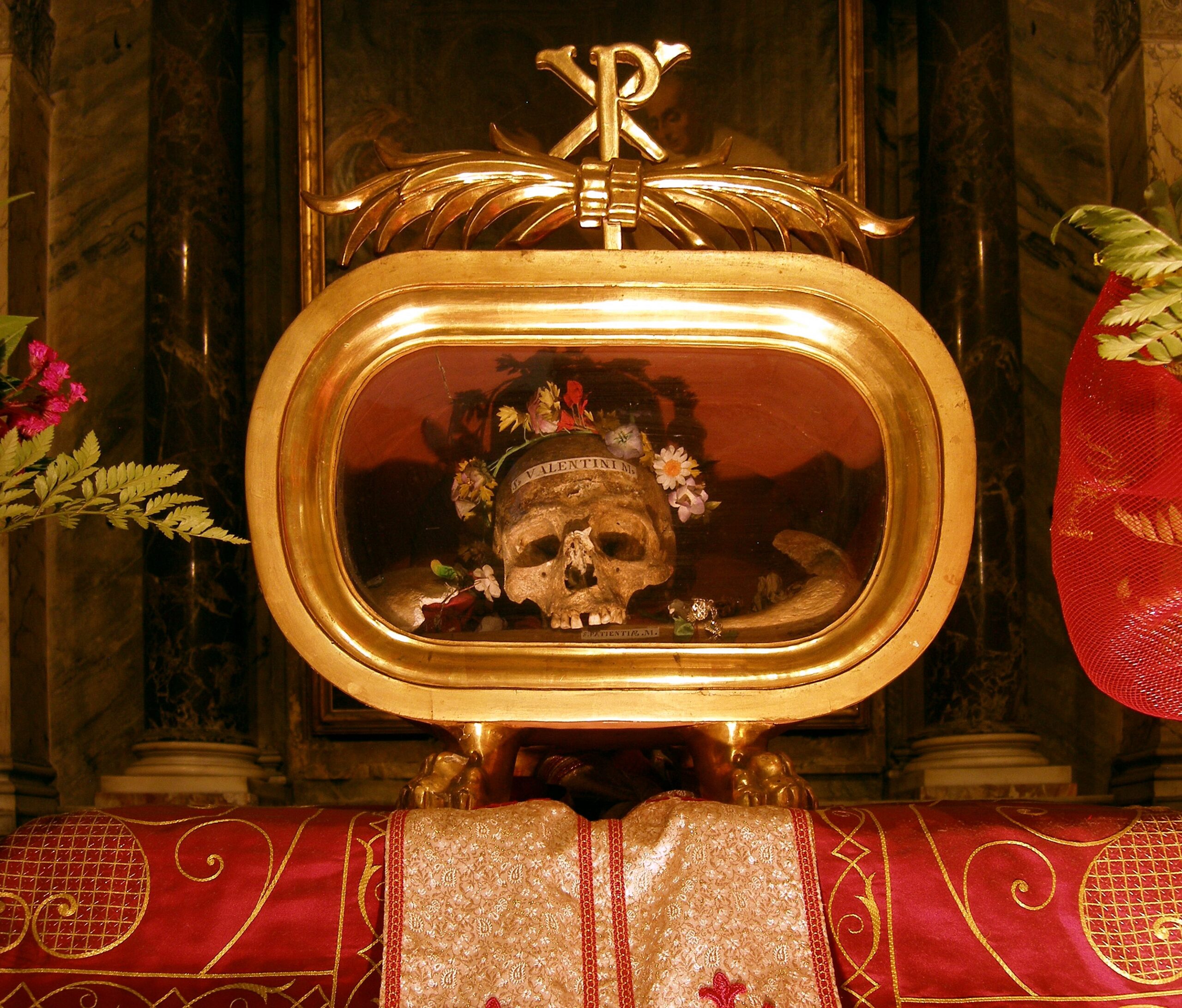
-skull of St. Valentine (226-14 Feb 269 AD), Bishop/Priest & Martyr, in the church of Santa Maria in Cosmedin, Rome, please click on the image for greater detail. He was martyred and his body buried at a Christian cemetery on the Via Flaminia close to the Ponte Milvio to the north of Rome, on February 14, which has been observed as the Feast of Saint Valentine (Saint Valentine’s Day) since 496 AD. “Love is stronger than death.”
Relics of him were kept in the Church and Catacombs of San Valentino in Rome, which “remained an important pilgrim site throughout the Middle Ages until the relics of St. Valentine were transferred to the church of Santa Prassede during the pontificate of Nicholas IV”. His skull, crowned with flowers, is exhibited in the Basilica of Santa Maria in Cosmedin, Rome; other relics of him were taken to Whitefriar Street Carmelite Church in Dublin, Ireland, where they remain; this house of worship continues to be a popular place of pilgrimage, especially on Saint Valentine’s Day, for those seeking love.


–Tees to the Kingdom, St Valentine shirts, please click on the images for greater detail

-reliquary containing the heart of St Valentine, Whitefriar Street Carmelite Church
“I like Saint Valentine. I am also a big fan of Christian marriage, and he was martyred for illegally presiding over Christian marriages. Through some bizarre accident of history, his feast-day is observed by the secular world, but the Church has taken him off the General Calendar. Unfortunately, I think very few people who mark this day on their personal calendars ever consider the life of the saint or the reason he died. This is but a reflection of a deeper problem: just as the world celebrates the feast of the patron of love without actually celebrating the patron himself, so also the world celebrates romantic love without actually thinking much about what love is in the first place.
In his book Love and Responsibility (written before he became Pope), Saint John Paul II impugns the idea that the point of a relationship is for both members to derive pleasure from it. The problem with this idea is that pleasure is not really a goal; there is no pleasure except pleasure in something. We eat cake for pleasure. We do not eat pleasure directly. No cake, no pleasure. Somehow, the world is trying to eat for pleasure without thinking too much about the step where you actually put food in the mouth. Such is a relationship of pure pleasure, nonsensical.
Any relationship, not just marriage, needs to be based on a common goal. For example, people who cooperate for an end in itself (hobby, being in a band – the goal is music, art/musical appreciation, volunteering, etc). These sorts of relationships (friendships, partnerships, mutual interests, fellow aficionados, etc.) often lead to the pleasure of relationship, but a relationship that is only founded upon mutual pleasure is actually the most unstable, because pleasure is so ephemeral. This can be said of emotional as well as physical pleasures. The deep feeling of contentment that arises when silently beholding a sunset with a lover is certainly a high pleasure, even the stuff of poetry, but that delight must give way to a chilly night. When night falls, something more than the sunset must remain to keep the relationship together.
Marriage is the most profound of human relationships, and so it must be based on the highest goal. That goal is nothing but the giving of one’s entire self. Saint John Paul II teaches that such giving is perfected only in procreation. It is in the bearing and raising of children that man and woman give themselves so fully that they make more of each other. Only by pursuing together the good of children can the couple really be united, even if the hope for children never comes to fruition. If either withholds this gift, the relationship becomes one of mere pleasure or convenience or some other friendly pursuit.
Children can make life difficult. They demand self-sacrifice, especially when they present particular difficulties. It is not easy. Sleeplessness is not fun. No engaged couple dreams of interminable appointments with doctors and therapists of various stripes.
At the same time, the gift of existence is one of the greatest gifts, despite the price. God, the giver of all existence, allows a man and a woman to share in His goodness by transmitting this most precious gift to their child. They can do this only with and through each other. The giving of this gift is fulfilling, because it is the gift that we were made to give. Giving this gift gives real joy.
This goal of procreation does not replace all the other goods of marriage. Instead, it makes them possible. A marriage can only be more than a house-sharing agreement if it aspires to a higher goal. Sexual union can only be more than an ‘arrangement’ if it aspires to something more than physical pleasure. The joy of self-giving can only be felt in the actual giving of oneself. The work of arranging one’s life around these different goods can, of course, be difficult, but the order of goods that the Church provides allows marriage to be structured firmly and stably. Only then can the desire to love be fulfilled. The passing on of existence is the only sufficient basis for marital love.”
“The matrimonial covenant, by which a man and a woman establish between themselves a partnership of the whole of life, is by its nature ordered toward the good of the spouses and the procreation and education of offspring; this covenant between baptized persons has been raised by Christ the Lord ” (CCC No. 1601)…
“So, if one of these conditions is intentionally left out, then no marriage takes place,” Father Thomas Urban, who is a judge at the Metropolitan Tribunal in Detroit, Michigan said. “I’ll marry you but not for the rest of our lives — no marriage. Or, I’ll marry you only if I can continue my bachelor lifestyle — no marriage. Or, I’ll marry you but I will not have any children — no marriage.” – Our Sunday Visitor Catholic Publishing, Oct 11 2017, https://www.osvnews.com/2017/10/11/can-catholic-couples-choose-childlessness/
“Decisions involving responsible parenthood presupposes the formation of conscience, which is ‘the most secret core and sanctuary of a person. There each one is alone with God, Whose voice echoes in the depths of the heart’ (Gaudium et Spes, 16). The more the couple tries to listen in conscience to God and His commandments (cf. Rom 2:15), and is accompanied spiritually, the more their decision will be profoundly free of subjective caprice and accommodation to prevailing social mores.” The clear teaching of the Second Vatican Council still holds: ‘[The couple] will make decisions by common counsel and effort. Let them thoughtfully take into account both their own welfare and that of their children, those already born and those which the future may bring. For this accounting they need to reckon with both the material and the spiritual conditions of the times as well as of their state in life. Finally, they should consult the interests of the family group, of temporal society and of the Church herself. The parents themselves and no one else should ultimately make this judgment in the sight of God.’
— Pope Francis, Amoris Laetitia No. 222 (first quoted passage taken from the final document of the 2015 Synod of Bishops)
Sex is both unitive and procreative, and the two cannot be separated. Each is the point of the other.

-by Giovanni Gasparro, Saint Valentine of Terni. The miracle of Craton’s son . Oil on canvas, 200×100 cm, 2021. Basilica of San Valentino, Terni. The first panel of a diptych.

-by Giovanni Gasparro, “Saint Valentine of Terni. The martyrdom of St. Valentine”. Oil on canvas, 200×100 cm, 2021. Basilica of San Valentino, Terni, the second panel of the diptych.
I love you, Kelly & Mara. Thanks, Mom & Dad,
Matthew



